Table tennis, also known as ping pong, is a famous sport people of all ages and skill levels enjoy.
If you’re new to the game or just looking to brush up on your knowledge, you might wonder what the five rules of table tennis are.
In this article, we’ll explore the fundamental rules that govern this exciting sport, from serving and scoring to the critical role of the table itself.
So grab your paddle, and let’s dive into the fundamentals of table tennis! Table tennis, also known as ping pong, is a popular indoor sport enjoyed by people of all ages.
To ensure fair and competitive play, specific rules must be followed. This article will discuss the five main rules of table tennis and provide a comprehensive guide to the game.
This image is the property of www.rookieroad.com.
Review contents
The Serve
The serve is the starting point of every table tennis game. The service sequence begins with the server standing behind the end line of their side of the table, holding the ball in an open palm.
They must toss the ball at least 6 inches into the air and strike it with the racket, aiming to hit it diagonally across the net to the opponent’s court. The ball must bounce on the server’s side of the table and then pass over the net without touching it. If the service is not done correctly, it will result in a service fault.
Rallying
Once the ball is in play, the players continuously rally, hitting the ball back and forth across the net. The ball must be hit so it bounces once on each side of the net during the rally.
Players can use various techniques to hit the ball, such as topspin, backspin, or a flat hit. Staying focused and maintaining good footwork is essential to return the ball effectively.
This image is the property of www.tabletennisengland.co.uk.
Scoring
The scoring system in table tennis is relatively straightforward. Each player or team starts with zero points, and a point is awarded to the player or team that wins a rally. The first player or team to reach 11 points wins a game, but there is a slight twist.
If the score reaches 10-10, a tie-breaker is played. In the tie-breaker, players continue to serve one point alternately until one player or team achieves a two-point lead. The winning score in a tie-breaker is 11 points.
Doubles Play
Doubles play in table tennis adds extra complexity to the game. Two players are on each team in doubles, and the server rotates after each game. The service order is determined at the beginning of the match and must be followed throughout.
The receiver position is fixed, and players must take turns hitting the ball during the rally. Good communication is crucial to avoid confusion and ensure effective teamwork.
This image is the property of i.ytimg.com.
Equipment
To play table tennis, specific equipment is required. The table dimensions should be 9 feet long, 5 feet wide, and 2.5 feet high. The net height should be 6 inches and stretch across the entire width of the table.
Rackets used in table tennis have certain specifications regarding size, shape, and material. The ball used in the game should have a diameter of 40mm and weigh 2.7g. It is vital to use legal equipment to ensure fair play.
Service Sequence
The service sequence has specific rules that must be followed. The server has two attempts to serve the ball correctly. If the first serve is a fault, a second serve is given. The receiver must be ready and stationary before the ball is served.
The server must aim to hit the ball so it bounces first on their side of the table, passes over the net, and lands on the receiver’s side. A point is awarded to the receiver if the server commits consecutive faults. The umpire is crucial in ensuring the service sequence is followed correctly.
This image is the property of www.customtabletennis.co.uk.
Starting the Serve
When starting the service, the server has to be in a specific service position behind the end line. The server’s free hand should be in an open palm position and not touch any part of the table during the serve.
Tossing the ball at least 6 inches into the air and striking it cleanly with the racket is essential. Some players may use hidden serves to confuse their opponents, but they must ensure their serve is legal according to the rules.
Ball Placement
During the serve, the server has control over the ball placement. They can serve the ball cross-court or long, aiming for the far end of the opponent’s court. Alternatively, they can serve the ball wide or short, aiming for the corners of the opponent’s court.
The middle serve aims for the opponent’s body, making it difficult for them to return the ball effectively. The server can vary their service placement to keep the receiver on their toes, while the receiver must strategize to return the ball successfully.
This image is the property of Amazon.com.
Ball Bouncing
In table tennis, there is a rule known as the “one-bounce” rule. This means that during the rally, the ball must bounce once on each side of the net. However, there are exceptions to this rule.
It is considered a legal shot if the ball hits the net but still lands on the opponent’s side. Similarly, if the ball hits the table’s edge and still lands on the opponent’s side, it is called an “edge ball” and counts as a legal shot. Players must be prepared to react quickly to these situations and adjust their shots accordingly.
Dispute Resolution
Occasionally, disputes may arise during a table tennis match, whether regarding rule interpretation or player conduct. It is essential to handle these disputes fairly and impartially.
Rule interpretation should be made based on the official rulebook, and players can protest if they believe a rule has been incorrectly applied. Umpires should provide impartial assistance in resolving disputes and focus on maintaining a friendly and sportsmanlike atmosphere. Ultimately, player reconciliation should be encouraged to ensure a positive playing experience for all.
In conclusion, table tennis is a thrilling and fast-paced sport that requires skill, agility, and good sportsmanship. Players can engage in fair and competitive play by following the five main rules of table tennis. Whether playing singles or doubles, understanding the rules and techniques of the game is essential for a successful match. So grab a racket, gather your friends, and enjoy the exciting world of table tennis!




























![Best Outdoor Dartboards [Reviews and Buying Guide 2024] Best Outdoor Dartboards](https://gamersets.com/wp-content/uploads/2022/12/Best-Outdoor-Dartboards-100x70.jpg)

![Best Mini Air Hockey Table [Reviews & Buying Guide 2024] Best mini air hockey table](https://gamersets.com/wp-content/uploads/2022/10/Best-mini-air-hockey-table-100x70.jpg)







